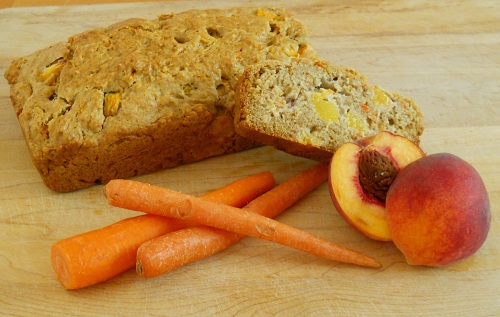The past two weeks have been fun and fast. My son and I were spending time in the Chicago area celebrating my beautiful mother’s 60th birthday during the first week. Then last week I spent every moment I could with my kids since it was the last week of their summer vacation. That’s right, today I sit in a silent house while they are at school. I’m actually kind of sad. I’ve had so much fun with them this summer. I’m also a little sentimental because my daughter has started High School. But it’s going to be an exciting year, because she made Varsity Cheerleading. I am so proud of my baby girl! I could keep going on and on about my kids. But you aren’t here for that.
Let’s begin with our regularly scheduled recipes. Today I bring you this wonderful spiced peach and carrot bread. This was in the July issue of Southern Living magazine. My grandmother was in town when it came in and she saw it and asked that it be made. I had to agree with Nana because the recipe sounded wonderful. Plus I knew it would work with splenda. Both my husband and Nana are diabetics, so anything I can bake with splenda, I will. It turned out just as good as I figured it would. It was moist and best served warm with butter. You can reheat it in the microwave for a few seconds to warm it up. I did omit the nuts because I’m not a big fan of nuts in baked goods. Spiced Peach and Carrot Bread is a great way to use up what’s left of summer peaches!
Spiced Peach and Carrot Bread:
- 3/4 cup chopped pecans(optional)
- 2 1/2 cups all-purpose flour
- 1 cup granulated sugar or Splenda
- 1 tsp ground cinnamon
- 1/4 tsp ground nutmeg
- 3/4 tsp baking soda
- 1/2 tsp baking powder
- 1/2 tsp salt
- 1 1/2 cups peeled and chopped fresh, ripe peaches (about 2-3 medium peaches)
- 3/4 cup freshly grated carrots (about 2 carrots)
- 2/3 cup vegetable oil
- 1/2 cup milk (buttermilk would be really good)
- 2 large eggs, lightly beaten
- Preheat the oven to 350 degrees. Toast pecans in a single layer on a baking sheet 8-10 minutes, or until toasted and fragrant, stirring halfway through. Cool 15 minutes.
- Whisk together the flour and next 6 ingredients in a large bowl. Add peaches and next 4 ingredients, and toasted pecans, stirring just until dry ingredients are moistened. Spoon the batter into a lightly greased 9×5 inch loaf pan (the batter will be very thick).
- Bake at 350 for 55-65 minutes, or until a wooden toothpick inserted in the center comes out clean.
- Cool the bread in the pan for 5-10 minutes, then run a knife around the edges and invert onto a cooling rack to cool completely.







